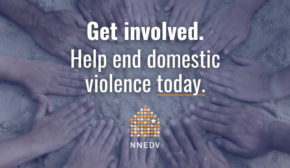NNEDV Recognizes Human Trafficking Awareness Month
January 11, 2014
January 11, 2014 – January is Human Trafficking Awareness Month. This and every month, the National Network to End Domestic Violence (NNEDV) stands in solidarity with survivors of human trafficking and the movement to end violence against women.
Violence against women persists in this country and around the world at epidemic levels and in many forms, including human trafficking, stalking, and domestic, sexual, and dating violence. It is therefore essential to the safety of these survivors to shine a light on what we know and discuss how to end violence in all forms.
What we know:
- Intimate partner violence can affect anyone, regardless of age, gender, nationality, socio-economic status, race, or faith.
- Intimate partner violence and human trafficking violate a person’s human rights and individual freedom.
- Violence occurs at a staggering rate in the United States:
- Domestic violence affects more than 12 million people each year.*
- One in four women has been a victim of severe physical violence by an intimate partner.*
- Nearly one in five women has been raped in their lifetime.*
- Victims of human trafficking are isolated and have limited places to turn for immediate help when seeking shelter and safety. In 2012, 63% of domestic violence shelters provided services for victims of trafficking.**
- Women were referenced as victims in 85% of sex trafficking cases, and men in 40% of labor trafficking cases.***
- In more than 40% of sex trafficking cases and in 20% of labor trafficking cases, U.S. citizens are referenced as victims.***
- From December 7, 2007 to December 31, 2012, the National Human Trafficking Resource Center (NHTRC) answered 65,557 calls, 1,735 online tip forms, and 5,251 emails – totaling more than 72,000 interactions.***
How to help end it:
- Be informed
- You can learn more about human trafficking from organizations who work every day to end it, such as the Polaris Project
- Talk about the issues with those you care about.
- Support local programs and advocacy groups whose mission is to end violence against women by giving your time or resources.
* Human Trafficking Trends in the U.S.: Statistics from the National Human Trafficking Resource Center 2007-2013, polarisproject.org/traffickingtrends
** Centers for Disease Control and Prevention (CDC) National Intimate Partner and Sexual Violence Survey, www.cdc.gov/violenceprevention/nisvs/
***2012 Domestic Violence Counts: National Census of Domestic Violence Services, nnedv.org/census





